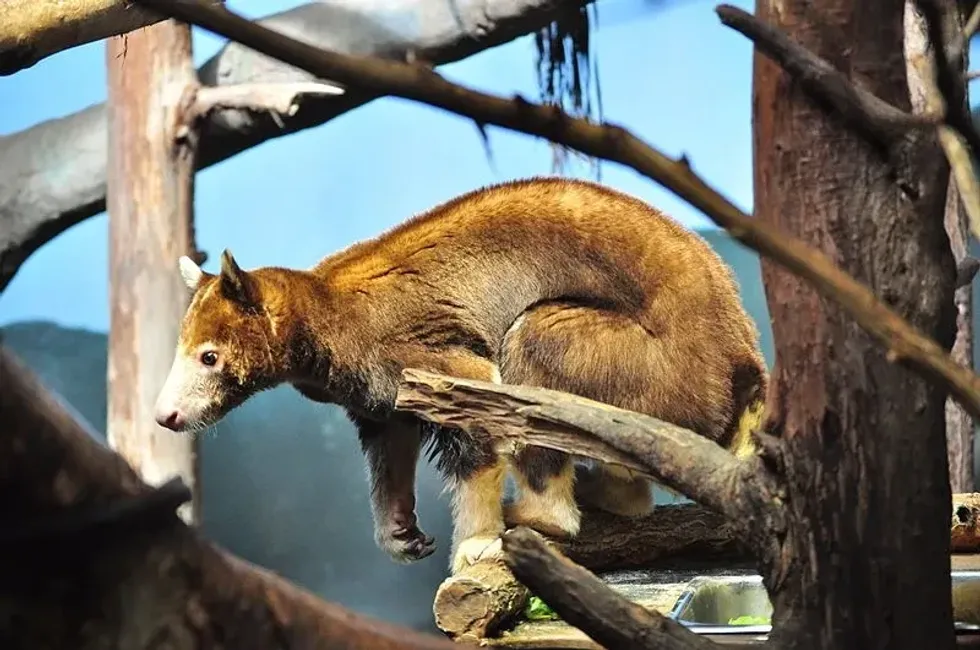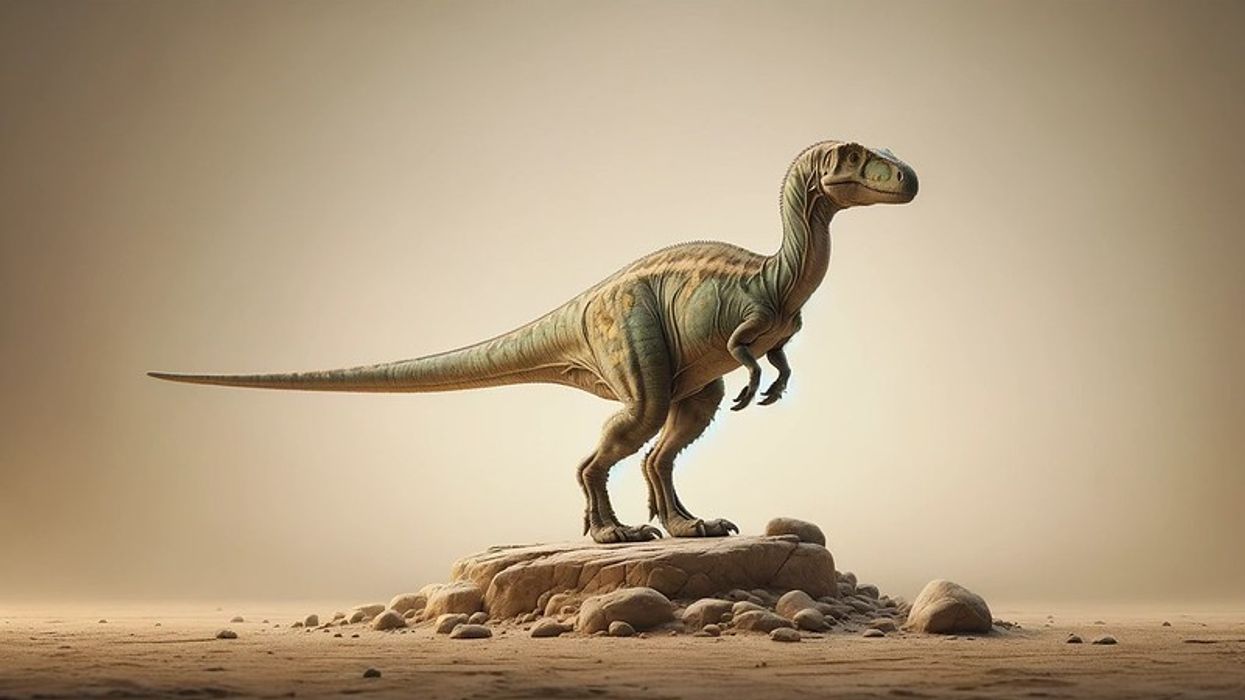A species of tree-kangaroo, the Dendrolagus mbaiso, also known as the dingiso, is endemic to the Papua province of western New Guinea situated in northeastern Indonesia. The dingiso primarily lives in alpine forests at an elevation of 10,660–13,780 ft (3,249–4,200 m).
Unlike other species of tree-kangaroos, the dingiso is not actually found on trees. The species is known by other names too, such as bondegezou and mbaiso. The term mbaiso means 'the forbidden animal'.
These tree-kangaroos possess black and white fur. They have a white belly, a black head, black back, and black limbs. They are around 26 in (67 cm) in length and female dingisos weigh around 18-20 lb (8-9 kg).
The species is herbivorous and they usually feed on leaves, fruits, and tree bark. Some other species of tree-kangaroos occasionally prey on eggs and young birds.
The International Union for Conservation of Nature has declared the species Endangered due to a steep population decline. Human activities in the form of hunting and predation are both major threats to the species, resulting in this official Endangered status.
Keep on reading to learn more interesting facts about the dingiso. If you want to know more exciting information about different animals, check out our articles on the kangaroo and Matschie's tree-kangaroo.
Dingiso Interesting Facts
What type of animal is a dingiso?
The Dendrolagus mbaiso, also known as the dingiso or bondegezou, is a species of tree-kangaroo. The species is primarily found in the Papua province of western New Guinea situated in northeastern Indonesia.
What class of animal does a dingiso belong to?
The dingiso belongs to the class of Mammalia, the family of Macropodidae, and the Dendrolagus genus.
How many dingisos are there in the world?
The exact dingiso population is not known as of now but the IUCN Red List suggests that the population of the species is constantly declining. Several species of tree-kangaroo have the status Critically Endangered. Data released in 2014 states that the population of Matschie's tree-kangaroos is around 2500.
Where does a dingiso live?
The dingiso (Dendrolagus mbaiso) is endemic to the Papua province of western New Guinea situated in northeastern Indonesia.
What is a dingiso's habitat?
The typical dingiso habitat is found in forests. This tree-kangaroo lives in alpine forests at an elevation of 10,660–13,780 ft (3,249–4,200 m). Unlike other species of tree-kangaroo, these animals are hardly found on trees.
Who do dingisos live with?
Very little information regarding the behavior of the species is available but like other species of tree-kangaroos, it is said that dingisos are solitary animals who prefer to live alone. These animals generally appear in pairs during the breeding season.
How long does a dingiso live?
The lifespan of dingisos is not known but other species such as the Dendrolagus matschiei live for around eight to 14 years. This tree-kangaroo generally lives longer in captivity.
How do they reproduce?
Like other species of tree-kangaroos, dingisos follow the same mating patterns. Tree-kangaroos become sexually mature at two years of age and are able to reproduce for 10-12 years.
Before breeding, these mammals are involved in several courtship displays that include tongue-clicking, hissing, and more. Females generally go through an estrous or heat cycle that occurs every 51-79 days and the animals mate on the ground.
The gestation period generally lasts for around 39-45 days and females isolate themselves for 24-48 hours prior to giving birth. Tree-kangaroo females generally give birth to single offspring.
Unlike other species of kangaroos, the offspring (or joey) of a tree-kangaroo generally does not leave the pouch for around 350 days. Males are involved in parenting.
What is their conservation status?
The International Union for Conservation of Nature has declared the dingiso (Dendrolagus mbaiso) as Endangered due to a constant population decline. Human activities in the form of hunting and predation are both major threats to the species.
Dingiso Fun Facts
What do dingisos look like?
Unlike Matschie's tree-kangaroos, dingisos possess black and white fur. They have a white belly, a black head, black back, and black limbs.

*Please note that this is an image of a Matschie's tree-kangaroo, not a dingiso. If you have an image of a dingiso, please let us know at hello@kidadl.com.
How cute are they?
Dingisos are regarded as one of the cutest marsupials. It is so cute to watch their joeys come out of the pouch.
How do they communicate?
Like other species of tree-kangaroo, the dingiso uses the same methods to communicate. A good sense of smell and touch, and good vision and hearing abilities help this species understand their surroundings. Also, they have a few alarm calls that help them to avoid predation.
How big is a dingiso?
The average adult dingiso size is about 26 in (67 cm) and a dingiso weighs around 18-20 lb (8-9 kg). The species is said to be 15 times heavier than the marsupial mole. Dingisos are bigger than a few species of wallaby.
How fast can a dingiso run?
The exact speed of a dingiso is not known but this species of tree-kangaroo is said to run at the speed of 25 mph (40 kph). These tree-kangaroos can also occasionally reach the speed of 45 mph (72 kph)
How much does a dingiso weigh?
The average weight of a dingiso would be around 18-20 lb (8-9 kg).
What are their male and female names of the species?
A male kangaroo is known as a 'buck', while a female kangaroo is called a 'jill'.
What would you call a baby dingiso?
People often use the term 'joey' to refer to a baby dingiso.
What do they eat?
Dingisos are herbivores who primarily feed on leaves, fruits, and tree bark. They forage for and eat their food both from the tops of trees and from the forest floor. Those living in captivity can also prey on eggs, birds, and small snakes. Animals such as the Australian dingo and the python are both major predators of tree-kangaroos.
Are they dangerous?
Very little information regarding the social behavior of the dingiso (Dendrolagus mbaiso) is available but, like other species of tree-kangaroo, the dingiso is believed to be a solitary animal. The species generally does not pose any danger or threat to humans but they can turn violent if someone tries to provoke or approach them.
Would they make a good pet?
It is not legal to keep tree-kangaroos as pets as several species are declared Endangered by the IUCN Red List. You can spot these beautiful animals in zoos and parks.
Did you know...
The dingiso first appeared in the 'South Pacific' TV series, a BBC documentary in 2009.
These animals are not extinct. They are listed as Endangered by the IUCN.
'Dingiso' pronunciation is super simple. The best way to pronounce this animal's name is to divide the words:'din-giso.'
Are tree-kangaroos related to kangaroos?
Yes, as both animals are Macropods. Kangaroos belong to the infraclass Marsupialia. Species such as kangaroos and wallabies were arboreal but later became terrestrial after evolution. Like their ancestors, one of the members of the Macropodidae family, the tree-kangaroo also later became arboreal.
Types of tree-kangaroos?
Apart from the dingiso, there are 12 more species of tree-kangaroos. A few species are the grizzled tree-kangaroo, Bennett's tree-kangaroo, Doria's tree-kangaroo, the tenkile, and Seri's tree-kangaroo. Unlike other species, the dingiso and ursine tree-kangaroos both possess black and white fur.
Here at Kidadl, we have carefully created lots of interesting family-friendly animal facts for everyone to discover! Learn more about some other mammals from our Chihuahua Terrier mix facts and dunker facts pages.
You can even occupy yourself at home by coloring in one of our free printable tree-kangaroo coloring pages.
*Please note that the main image is of a Matschie's tree-kangaroo, not a dingiso. If you have an image of a dingiso, please let us know at hello@kidadl.com.










